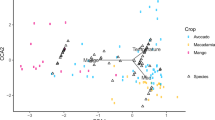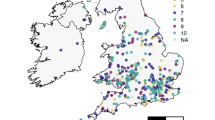Abstract
During the past decades, managed honeybee stocks have increased globally. Managed honeybees are particularly used within mass-flowering crops and often spill over to adjacent natural habitats after crop blooming. Here, we uniquely show the simultaneous impact that honeybee spillover has on wild plant and animal communities in flower-rich woodlands via changes in plant–pollinator network structure that translate into a direct negative effect on the reproductive success of a dominant wild plant. Honeybee spillover leads to a re-assembly of plant–pollinator interactions through increased competition with other pollinator species. Moreover, honeybee preference for the most abundant plant species reduces its seed set, driven by high honeybee visitation rates that prevent pollen tube growth. Our study therefore calls for an adequate understanding of the trade-offs between providing pollination services to crops and the effects that managed pollinators might have on wild plants and pollinators.
This is a preview of subscription content, access via your institution
Access options
Access Nature and 54 other Nature Portfolio journals
Get Nature+, our best-value online-access subscription
$29.99 / 30 days
cancel any time
Subscribe to this journal
Receive 12 digital issues and online access to articles
$119.00 per year
only $9.92 per issue
Buy this article
- Purchase on Springer Link
- Instant access to full article PDF
Prices may be subject to local taxes which are calculated during checkout



Similar content being viewed by others
References
Aizen, M. A., Garibaldi, L. A., Cunningham, S. A. & Klein, A. M. Long-term global trends in crop yield and production reveal no current pollination shortage but increasing pollinator dependency. Curr. Biol. 18, 1572–1575 (2008).
Aizen, M. A. & Harder, L. D. The global stock of domesticated honey bees is growing slower than agricultural demand for pollination. Curr. Biol. 19, 915–918 (2009).
Kleijn, D. et al. Delivery of crop pollination services is an insufficient argument for wild pollinator conservation. Nat. Commun. 6, 7414 (2015).
Kennedy, C. M. et al. A global quantitative synthesis of local and landscape effects on wild bee pollinators in agroecosystems. Ecol. Lett. 16, 584–599 (2013).
Rader, R. et al. Alternative pollinator taxa are equally efficient but not as effective as the honeybee in a mass flowering crop. J. Appl. Ecol. 46, 1080–1087 (2009).
Blitzer, E. J. et al. Spillover of functionally important organisms between managed and natural habitats. Agric. Ecosyst. Environ. 146, 34–43 (2012).
Montero-Castaño, A. & Vilà, M. Influence of the honeybee and trait similarity on the effect of a non-native plant on pollination and network rewiring. Funct. Ecol. 31, 142–152 (2017).
González-Varo, J. P. & Vilà, M. Spillover of managed honeybees from mass-flowering crops into natural habitats. Biol. Conserv. 212, 376–382 (2017).
Sáez, A., Morales, C. L., Ramos, L. Y. & Aizen, M. A. Extremely frequent bee visits increase pollen deposition but reduce drupelet set in raspberry. J. Appl. Ecol. 51, 1603–1612 (2014).
Thomson, D. M. Local bumble bee decline linked to recovery of honey bees, drought effects on floral resources. Ecol. Lett. 19, 1247–1255 (2016).
Cane, J. H. & Tepedino, V. J. Gauging the effect of honey bee pollen collection on native bee communities. Conserv. Lett. 10, 205–210 (2016).
Torné-Noguera, A., Rodrigo, A., Osorio, S. & Bosch, J. Collateral effects of beekeeping: impacts on pollen–nectar resources and wild bee communities. Basic Appl. Ecol. 17, 199–209 (2016).
Brosi, B. J. & Briggs, H. M. Single pollinator species losses reduce floral fidelity and plant reproductive function. Proc. Natl Acad. Sci. USA 110, 13044–13048 (2013).
Geslin, B. et al. Massively introduced managed species and their consequences for plant–pollinator interactions. Adv. Ecol. Res. 57, 147–199 (2017).
Herbertsson, L., Lindström, S. A. M., Rundlöf, M., Bommarco, R. & Smith, H. G. Competition between managed honeybees and wild bumblebees depends on landscape context. Basic Appl. Ecol. 17, 609–616 (2016).
Coffey, M. F. & Breen, J. Seasonal variation in pollen and nectar sources of honey bees in Ireland. J. Apic. Res. 36, 63–76 (1997).
Gross, C. L. The effect of introduced honeybees on native bee visitation and fruit-set in Dillwynia juniperina (Fabaceae) in a fragmented ecosystem. Biol. Conserv. 102, 89–95 (2001).
Grüter, C., Moore, H., Firmin, N., Helanterä, H. & Ratnieks, F. L. W. Flower constancy in honey bee workers (Apis mellifera) depends on ecologically realistic rewards. J. Exp. Biol. 214, 1397–1402 (2011).
von Frisch, K. The Dance Language and Orientation of Bees (Harvard Univ. Press, Cambridge, 1965).
Vanbergen, A. J., Woodcock, B. A., Heard, M. S. & Chapman, D. S. Network size, structure and mutualism dependence affect the propensity for plant–pollinator extinction cascades. Funct. Ecol. 31, 1285–1293 (2017).
FAOSTAT: Statistical Databases and Data-Sets (FAO, Rome, 2014).
Aizen, M. A. & Harder, L. D. Geographic variation in the growth of domesticated honey bee stocks: disease or economics? Commun. Integr. Biol. 2, 464–466 (2009).
FAOSTAT Database on Agriculture (FAO, Rome, 2014).
Fründ, J., McCann, K. S. & Williams, N. M. Sampling bias is a challenge for quantifying specialization and network structure: lessons from a quantitative niche model. Oikos 125, 502–513 (2015).
de Menezes Pedro, S. R. & de Camargo, J. M. F. Interactions on floral resources between the Africanized honey bee Apis mellifera L and the native bee community (Hymenoptera: Apoidea) in a natural “cerrado” ecosystem in southeast Brazil. Apidologie 22, 397–415 (1991).
Garibaldi, L. A. et al. Wild pollinators enhance fruit set of crops regardless of honey bee abundance. Science 339, 1608–1611 (2013).
Holzschuh, A. et al. Mass-flowering crops dilute pollinator abundance in agricultural landscapes across Europe. Ecol. Lett. 19, 1228–1236 (2016).
Magrach, A. et al. Plant–pollinator networks in semi-natural grasslands are resistant to the loss of pollinators during blooming of mass-flowering crops. Ecography https://doi.org/10.1111/ecog.02847 (2017).
González-Varo, J. P., Ortiz-Sánchez, F. J. & Vilà, M. Total bee dependence on one flower species despite available congeners of similar floral shape. PLoS ONE 11, e0163122 (2016).
Bosch, J. Floral biology and pollinators of three co-occurring Cistus species (Cistaceae). Bot. J. Linn. Soc. 109, 39–55 (1992).
Morales, C. L. & Traveset, A. Interspecific pollen transfer: magnitude, prevalence and consequences for plant fitness. Crit. Rev. Plant Sci. 27, 221–238 (2008).
Morris, W. Mutualism denied? Nectar-robbing bumble bees do not reduce female or male success of bluebells. Ecology 77, 1451–1462 (1996).
González-Varo, J. P., Albaladejo, R. G., Aparicio, A. & Arroyo, J. Linking genetic diversity, mating patterns and progeny performance in fragmented populations of a Mediterranean shrub. J. Appl. Ecol. 47, 1242–1252 (2010).
Fründ, J., Dormann, C. F., Holzschuh, A. & Tscharntke, T. Bee diversity effects on pollination depend on functional complementarity and niche shifts. Ecology 94, 2042–2054 (2013).
McGill, B. J. et al. Species abundance distributions: moving beyond single prediction theories to integration within an ecological framework. Ecol. Lett. 10, 995–1015 (2007).
Watts, S., Dormann, C. F., Martín González, A. M. & Ollerton, J. The influence of floral traits on specialization and modularity of plant–pollinator networks in a biodiversity hotspot in the Peruvian Andes. Ann. Bot. 118, 415–429 (2016).
Aebi, A. et al. Back to the future: Apis versus non-Apis pollination—a response to Ollerton et al. Trends Ecol. Evol. 27, 142–143 (2012).
Danner, N., Molitor, A. M., Schiele, S., Härtel, S. & Steffan-Dewenter, I. Season and landscape composition affect pollen foraging distances and habitat use of honey bees. Ecol. Appl. 26, 1920–1929 (2016).
Hsieh, T. C., Ma, K. H. & Chao, A. iNEXT: Iterpolation and Extrapolation for Species Diversity. R package v. 2.0.8. (R Foundation for Statistical Computing, Vienna, 2016).
Tylianakis, J. M., Tscharntke, T. & Lewis, O. T. Habitat modification alters the structure of tropical host–parasitoid food webs. Nature 445, 202–205 (2007).
Dormann, C. F., Frund, J., Bluthgen, N. & Gruber, B. Indices, graphs and null models: analyzing bipartite ecological networks. Open Ecol. J. 2, 7–24 (2009).
Müller, C. B., Adriaanse, I. C. T., Belshaw, R. & Godfray, H. C. J. The structure of an aphid–parasitoid community. J. Anim. Ecol. 68, 346–370 (1999).
Blüthgen, N., Menzel, F. & Blüthgen, N. Measuring specialization in species interaction networks. BMC Ecol. 6, 9 (2006).
Poisot, T., Canard, E., Mouillot, D., Mouquet, N. & Gravel, D. The dissimilarity of species interaction networks. Ecol. Lett. 15, 1353–1361 (2012).
Legendre, P. Interpreting the replacement and richness difference components of beta diversity. Glob. Ecol. Biogeogr. 23, 1324–1334 (2014).
Carvalheiro, L. G. et al. The potential for indirect effects between co-flowering plants via shared pollinators depends on resource abundance, accessibility and relatedness. Ecol. Lett. 17, 1389–1399 (2014).
Bartoń, K. MuMIn: Multi-Model Inference. R package v. 1.9.13 (R Foundation for Statistical Computing, Vienna, 2013); http://CRAN.R-project.org/package=MuMIn
Burnham, K. P., Anderson, D. R. & Huyvaert, K. P. AIC model selection and multimodel inference in behavioral ecology: some background, observations, and comparisons. Behav. Ecol. Sociobiol. 65, 23–35 (2011).
Cade, B. S. & Noon, B. R. A gentle introduction to quantile regression for ecologists. Front. Ecol. Env. 1, 412–420 (2003).
Lefcheck, J. S. piecewiseSEM: piecewise structural equation modelling in R for ecology, evolution, and systematics. Methods Ecol. Evol. 7, 573–579 (2016).
Acknowledgements
This project was partially funded by the EU FP7 STEP project ‘Status and trends of European pollinators’ (244 090; http://www.STEP-project.net) and Biodiversa-FACCE project ‘Enhancing biodiversity-based ecosystem services to crops through optimized densities of green infrastructure in agricultural landscapes’ (PCIN-2014-048, http://www.cec.lu.se/ecodeal), the Spanish Ministry of Economy and Competitiveness FLORMAS (CGL2012-33801) and the Severo Ochoa program (SEV-2012-0262). A.M. acknowledges funding from the Juan de la Cierva Incorporación program (IJCI-2014-22558). We thank R. Gómez, A. Carrillo-Gavilán, C. Molina and D. Ragel for their assistance in fieldwork. We thank J. M. Ortiz and A. Vujic for identifying most bee and hoverfly specimens, respectively.
Author information
Authors and Affiliations
Contributions
J.P.G.V. and M.V. conceived the experimental design; J.P.G.V., M.B. and A.M. collected field data; A.M. led data analysis and drafted the first version of the manuscript; I.B. participated in data analyses and helped draft the manuscript. All authors commented on manuscript drafts and gave final approval for publication.
Corresponding author
Ethics declarations
Competing interests
The authors declare no competing financial interests.
Additional information
Publisher’s note: Springer Nature remains neutral with regard to jurisdictional claims in published maps and institutional affiliations.
Electronic supplementary material
Supplementary material
Supplementary Tables 1–8; Supplementary Figures 1–9
Rights and permissions
About this article
Cite this article
Magrach, A., González-Varo, J.P., Boiffier, M. et al. Honeybee spillover reshuffles pollinator diets and affects plant reproductive success. Nat Ecol Evol 1, 1299–1307 (2017). https://doi.org/10.1038/s41559-017-0249-9
Received:
Accepted:
Published:
Issue Date:
DOI: https://doi.org/10.1038/s41559-017-0249-9
This article is cited by
-
Floral species evenness is the major driver of wild bee communities in urban gardens
Urban Ecosystems (2024)
-
Undestroyed winter cover crop strips support wild bee abundance and diversity in intensive cropping systems
Biodiversity and Conservation (2024)
-
The role of intra-guild indirect interactions in assembling plant-pollinator networks
Nature Communications (2023)
-
Exploring spatiotemporal dynamics of flower visitor association pattern on two Avicennia mangroves: a network approach
Environmental Monitoring and Assessment (2023)
-
Citizen science monitoring reveals links between honeybee health, pesticide exposure and seasonal availability of floral resources
Scientific Reports (2022)



